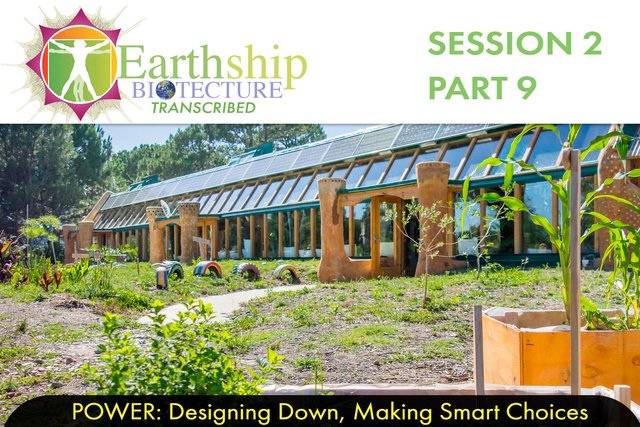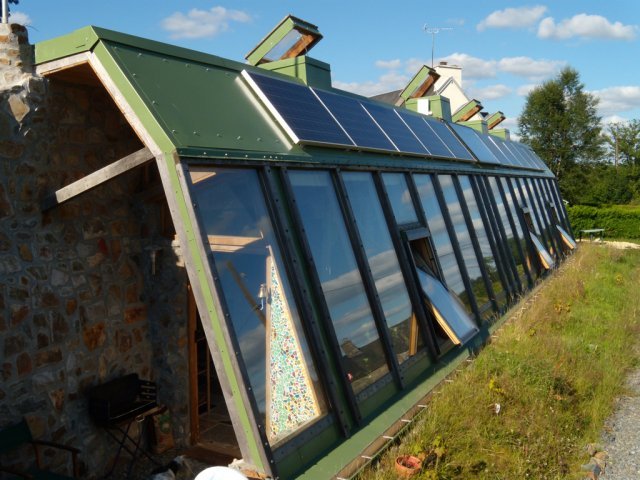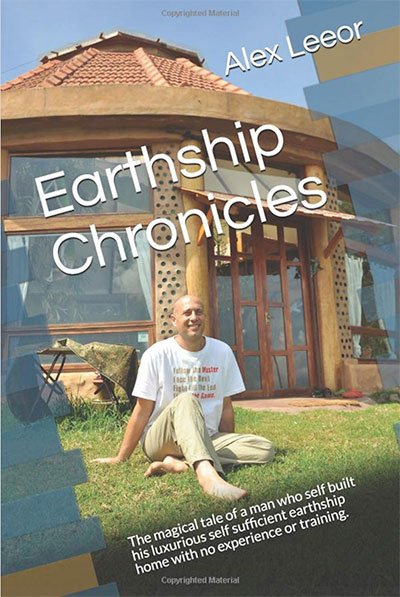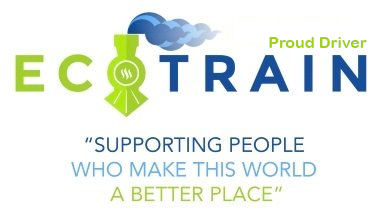Earthship Biotecture Transcribed: Session 2/ Part 9: SOLAR POWER: Designing Down, Making Smart Choices.

Commentary:
We continue our discussions on power systems. This part talks a lot about designing down. In biotecture this means that you really do your best to first reduce the amount of power you need. This means designing the house to function, as well as choosing the right appliances that draw least power and can get the job done. Note that it does not mean going without! In my Earthship i have chosen most of my appliances and tools to be cordless. I have a long list of cordless devices, and these can reduce power use from as much as 3,000Watts (using a regular vacuum cleaner, drill machine, and heating water with electricity for example) to about 30 Watts, and even that is only when they are charging!
Examples of Good choices when designing down and living completely on solar include:
- LED lights working without inverter power.
- Cordless vacuum cleaner using only 5-10 watts to charge.
- Laptop computer Vs Desktop. A laptop used 50-100 Watts. A desktop uses from 400Watts to 700Watts.
- Cordless Tools such as drill machines, circular saws etc.
- Use of 5* Energy
Efficient Appliances. For example my fridge freezer uses only 50 Watts and can be turned off all night and still hold its temperature. - Water is heated by solar only, never by electricity.
- All pumps are DC pumps/
- Cooking is never done with electricity. Gas or renewable energy source is the only option!
We also look at whether using systems like solar panel tracking are worth the expense and trouble (they are not!), and look at why the best solution to lack of power issues is usually to just buy more panels rather than try to introduce something new that adds further complementation. Keeping things simple and as close to zero maintenance with a long life are the priorities. We have to take TIME into account when making decisions. How long something lasts before it needs maintenance or replacing is a critical part of the considerations.
MY OFFICE SETUP, USING
LESS THAN 100 WATTS

LED LIGHTING AT EARTHSHIP KAUNRA

You can read more and see images of how I have organised power in Earthship Karuna at:
https://steempeak.com/ecotrain/@eco-alex/all-about-solar-power-at-earthship-karunaEarthship Seminar Transcription Session 2 -Part 9
We're making radical changes now in the amount of power used at the Phoenix Earthship. We're having to do that because our Tilapia... we've gotten so into our tilapia. We have pumps going to aerate the water, and that's a must... the water has to be aerated and circulated, and and it takes some power for them... and that's one of those situations where it's put us in a pinch. We've either got to buy more solar panels, or get smarter... and it just turns out that it's easy to get smarter, because LED lighting is really getting out there. We we took a 50 watt lighting situation and brought it down to five watts, that's like 10% of the power.
The new houses are going to be all LED, we're going back and retrofitting the old houses. You can see it the bulk of your load of electricity in one of these buildings is lighting at night. You know a little bit for a computer and the LED lighting is getting to be... it comes in... it's strange how they put stuff out there. It kind of works against us a little bit, because the best easiest to find LED lighting is AC... and they do make DC but it's only 12 volt... they make a few 24 volt DC s and that's what we use in these buildings, so for us to keep our lighting... some house lighting, emergency house lighting not on the AC inverter, we do have to use compact fluorescents. And see compact fluorescents were a big thing, they would they would cut it by 70% or something like that, maybe they cut it in half or whatever... but they're much more efficient than a regular incandescent bulb... but the LEDs are phenomenal... and they're getting to the point where they put them out they make a lot of light now too.
So we're switching the whole Phoenix... which is taking us a while... over to LEDs. All of the new buildings will be LEDs. So we're we're moving in the direction of cutting down the power use even further, and see a normal house... you can go into a normal house and put in LEDs these days... but still our power system is small because the Earthship doesn't need much power. It used to be, you would even see in some of the older buildings... s a slot for a generator because the backup generator just plugs in and charges through the system to the batteries. We don't even do that anymore... at the Phoenix we have had done that recently because of the tilapia... but now we've got the LEDs happening and they've more already more than compensating for the extra pumps for the tilapia.
So we don't use backup generators. We don't even prescribed them anymore in a regular home... they because the power system is set up with safeguards so you can't really screw it up... and LED lighting and just a minimal use of power. And still that minimal use of power the power system ends up costing 25 grand... (note that today in 2019 this figure is CAN be a little as $1,000-$3,000 dollars.).. and the nature of the building is these act these buildings actually cost say 15% less than equivalent conventional buildings... the equivalent quality conventional buildings... but then you throw in the power water and sewage that brings you up to the same or maybe five percent more.
If these people that buy this house in the first five years have over $100 a year utility bill will pay it. That's how sure we are..
So it is the systems that that make these buildings cost at least the same as conventional housing... but they make it so you have no utility bills... and having no utility bills one thing. You know having a house like one of the global models that we're selling.. we're guaranteeing to the realtor... if these people that buy this house in the first five years have over $100 a year utility bill will pay it. That's how sure we are.. So that's where it's at is its 's a saving in money but... it's more than a savings and money these days because it's a security. You're in a home that... if the economy crashes... is your power going to go out if there's a fuel shortage, is your power going to go out... Not in a home that's independent.
The point is be off of the grid... not just to be cheaper but to be more secure.
I push the concept more than anything... in other words maybe there are other ways to do all of this... I don't know who's doing it but I welcome any of it. The point is be off of the grid... not just to be cheaper but to be more secure. And then of course that ends up translating into carbon zero and a soft footprint on the planet of people. The planet could support 50 times as many people is around here now... if they were if they were living in a way that enhances the planet. Like a lot of answers I get for my own thinking are from trees...trees basically enhance the planet. They grow here, they they drop their foliage and make dirt, soil for new trees. They have their own photosynthesis, they have their own absorption of nutrients from the soil, they just make the planet better... they put out oxygen and take in co2, which fixes the planet. So that mammals have a better situation because they need oxygen... and so the trees are actually almost the guardians of the planet, and we're of course lunching them right and left... the rainforests and everything... but you never hear anybody say there are too many trees.
The trees are really the model citizens of the planet and we're trying to make humans do the same as trees do in terms of just logic.
I even get my feathers ruffled when people call me an environmentalist or something like that. I don't really buy all that... it's just logic . You know... if you enhance, though the world around you... then you're basically reinforcing your own existence really... and so that's kind of the logic that's behind these buildings... and so the buildings are aimed at treading softly on the planet, and needing less... just needing less. But it doesn't mean you're doing without anything, it means that you're strategically gathering what you need, and that's the way this power system is set up.
So if you have over 275 sunny days a year... I suggest staying with PV (solar) panels... and maybe experimenting with the thin film stuff too... We'll be putting it out on the website what we learn and all that kind of stuff.
(Question) Have you got a holding pond working?
Yeah. We got some in... and what we did is, in the Phoenix Earthship, the tilapia pond last fall got below sixty degrees in the water, which is lethal for tilapia they're a tropical fish... So we we were just getting ready to have a fish fry and all our fish died... and it was because the water got down to 58 degrees. So this year we got a swimming pool collector, and it's got a thin film panel powering a little submersible boat pump that shoves the water... whenever the sun's out... it shoves the water through the collector and and it comes out... it's probably just going to bump the water (temperature) up enough to keep it above sixty degrees. It's working and so we got a thin-film solar panel to do that and we observed the other day, it was cloudy but the pump was still working. So with the typical panels the pump would just go off. So the thin film solar panels everybody poo-poos them because they're they're not near as efficient... it takes more area for this amount of wattage than it does for the actual full-on panels... but who cares because thing is they make power in cloudy days.
In the end ends up per watt being even a little less expensive ... it's just they say they're not as durable for lasting forever , they're not as efficient... and so because everybody's out in the real world out there ...they need massive amounts of power to run their massive houses that have massive demands... the first thing on any level of survival is reduce your demands... first I mean... then you know if you're going to Everest on a track are you gonna take your grand piano with you or not? You make a decision... "well I want to stay alive up here so I really don't think I'm gonna take my grand piano".
And so the future is kind of a trek really... for people to to deal with the future. So you're designing your life down... again you're not doing without... you're just taking what's logical for you to take to Everest and what's logical for you to take into the future. So the buildings are designed down, and we can power them just fine with a minimal power system.
Add to add the element of time to any decision that you make, and it's going to vastly change your your mind on things.
So, that's kind of the the rationale behind the overall design of this power system. Then then there are things like... if you do use wind power, we are developing vertical axis windmills. We actually had one spin for 25 years with no maintenance... that's decent! Pillow block bearings, real basic... sure it's not as efficient as these little propeller ones, but the propeller ones are down (broken) every year. In other words... look at the overview. People tend to just go away from something if it's not as efficient, but look at it over time. Add to add the element of time to any decision that you make, and it's going to vastly change your your mind on things. As a matter of fact add the element of time to the whole concept of fossil fuel... you know it's gonna vastly change your mind on whether to even participate in fossil fuel to any degree or not.
So then if it's raining you're happy.. you're getting water.
If it's sunny you're happy... you're getting power.
If it's windy you're happy... you're getting power.
It's like you're happy all the time...
you're always getting something from the world around you.
So every decision that you make should be adding the element of time. So we are playing with vertical axis windmills that will be durable, that will last 25 years, that put out a little power. They're fun... it's fun to be sitting at night watching a vertical axis windmill pump power into your batteries... So then if it's raining you're happy.. you're getting water. If it's sunny you're happy... you're getting power. If it's windy you're happy... you're getting power. It's like you're happy all the time... you're always getting something from the world around you. There's no more rainy day issues.
But with solar panels then is... you'll see all kinds of different aspects of this all over the community... The first thing. one of these posts out here was a tracker... to track the Sun. So I was convinced by my electrician to use the tracker out here... notice it's not out here anymore... because the price of the tracker ($1,500) which would about maybe two panels... saves you the price of panels because it's always getting the most out of the Sun... because it's tracking it. What they don't tell you after using them is that if it's windy trackers blow out of the Sun... so if it's windy and sunny you're screwed. And in super cold climates it sort of doesn't really get started moving because it's all kind of frozen up until 11 ish... and then it quits again at 1:30 or 2:00pm,.. and then they blow down and break.. they are big sales ... and they look industrial and so on. So we learned very early on to blow off the tracker put that money into more panels... and we made our own little racks on the front of the buildings that adjust for the high (they had a hinge here) they adjust it out for the high summer sun and adjusted down for the lower winter sun.
That means you have to go up on your pro panel roof and fall on your ass and snow and adjust your panels twice a year. So we started going moving away from that, and the apparatus to even hinge these and mount them and do this cost as much as two or three more panels. So what we did was we just said okay, we'll put all of the money for trackers and racks and everything... buy more panels, bigger panels... and we'll decide what the average year angle is. And for here it's right at 45 degrees.
1KW SOLAR ARRAY AT EARTHSHIP KARUNA

Earthships and Indoor Solar Systems - Bhudeva

SOURCE
So if you notice on the global model there's a 45-degree slope, and then the steeper one.. and there's where our solar energy comes to, it's halfway between the winter and summer angle... no adjustments, no moving parts... and we're fine. In other words... all of this tracking and and in high-tech stuff just cost money, and is maintenance. The less technology you can get into, I mean we're definitely using high technology where solar panels and inverters and things... but just keep it simple. You keep the maintenance down and keep the price down and works fine. We put all the money into panels, we do not do tracking of any kind... so that's that's definitely the story on panels..

Earthship Seminar Video 2009 - Session 2 -Part 9
I would like to thank Mike Reynolds for giving me permission to transcribe, edit and reformat this work for the Steem Blockchain! If you do read or watch this and have any questions please ask in the comments. I am happy to educate and help you to understand this. Biotecture is amazing in so many ways, and even after 20 years I still have not seen a model of sustainable building that even comes close in so many important areas such as performance, carbon footprint, longevity, ease of build, etc... Now you can also come to understand what Biotecture Really Is about!

READ PREVIOUS TRANSCRIPTS
SESSION 1
Part 1: The Global Model
https://steemit.com/ecotrain/@eco-alex/earthship-biotecture-101-learn-with-michael-reynolds-part-1
Part 2: Staying Cool: The Convection Engine
https://steempeak.com/ecotrain/@eco-alex/earthship-biotecture-transcribed-seminar-with-michael-reynolds-transcribed-part-2
Part 3: The Evolution of the Global Model Earthship:
https://steempeak.com/ecotrain/@eco-alex/earthship-biotecture-transcribed-seminar-with-michael-reynolds-part-3
Part 4: Heating your home with body heat in Norway, about permits in USA and Europe... How to get them fast
https://steempeak.com/ecotrain/@eco-alex/earthship-biotecture-transcribed-pt4-heating-your-home-with-body-heat-in-norway-about-permits-in-usa-and-europe-how-to-get-them
Part 5: How to Retrofit, Getting Permits, Tire Toxicity?
https://steempeak.com/ecotrain/@eco-alex/earthship-biotecture-transcribed-pt-5-how-to-retrofit-getting-permits-tire-toxicity
Part 6: Bottle / Can Walls, Tyre Foundations / Snow Water
https://steempeak.com/ecotrain/@eco-alex/earthship-biotecture-transcribed-pt-6-q-and-a-bottle-can-walls-tyre-foundations-snow-water
Part 7: Can you insure an earthship?, the double/triple greenhouse, the global model evolution + more
https://steempeak.com/ecotrain/@eco-alex/earthship-biotecture-transcribed-pt-7-q-and-a-can-you-insure-an-earthship-the-double-triple-greenhouse-the-global-model
Part 8: Final: Year round fruiting trees, sizing greenhouses + more
https://steempeak.com/ecotrain/@eco-alex/earthship-biotecture-transcribed-pt-8-final-q-and-a-year-round-fruiting-trees-sizing-greenhouses-more
SESSION 2
Part 1: Water, how to size your roof, choosing the right materials for water catchment.
https://steempeak.com/ecotrain/@eco-alex/earthship-biotecture-transcribed-session-2-part-1-water-how-to-size-your-roof-choosing-the-right-materials-for-water-catchment
Part 2: Cisterns, Filtering Water, Designing Down & Layered Thinking.
https://steempeak.com/ecotrain/@eco-alex/earthship-biotecture-transcribed-session-2-part-2-cisterns-filtering-water-designing-down-and-layered-thinking
Part 3: Water! Be Self Sufficient Secure & Sustainable.
https://steempeak.com/ecotrain/@eco-alex/earthship-biotecture-transcribed-session-2-part-3-water-be-self-sufficient-secure-and-sustainable
Part 4: Botanical Cells, Using Water 4 Times, Food Production.
https://steempeak.com/ecotrain/@eco-alex/earthship-biotecture-transcribed-session-2-part-4-botanical-cells-using-water-4-times-food-production
Part 5 : The Solar Toilet, Making Mistakes and Evolving is Part of the Process.
https://steempeak.com/ecotrain/@eco-alex/earthship-biotecture-transcribed-session-2-part-5-the-solar-toilet-making-mistakes-and-evolving-is-part-of-the-process
Part 6: Black Water Treatment In Any Climate, Food Production.
https://steempeak.com/ecotrain/@eco-alex/earthship-biotecture-transcribed-session-2-part6-black-water-treatment-in-any-climate-food-production
Part 7: Q&A: Water, Botanical Cells, Water Treatment
https://steempeak.com/ecotrain/@eco-alex/earthship-biotecture-transcribed-session-2-part-7-q-and-a-water-botanical-cells-water-treatment
Part 8: About Solar Power, Doing It Yourself? Solar Vs Wind.
https://steempeak.com/ecotrain/@eco-alex/earthship-biotecture-transcribed-session-2-part8-about-solar-power-doing-it-yourself-solar-vs-wind

Did you know, I built four Earthships in India as well as being instrumental the creation of the first Earthship in the UK, Earthship Brighton. If you are also on this path and would like to read my story, I have recently published a book. It is not only a great story, but a valuable resource for you to learn from. I had no experience or training when I embarked on my mission, but managed to successfully build a gorgeous home called Earthship Karuna.
You can buy this book with Steem on the homesteaders co-op. Whilst you are there please do have a look at some of the other products as there are all kinds of great things there!


https://homesteaderscoop.com/product/earthship-chronicles-ebook/
If you don't have any Steem you can also buy the ebook and paperback on amazon.
http://mybook.to/Earthship-Chronicles
or
https://www.amazon.com/Earthship-Chronicles-sufficient-luxurious-experience-ebook/dp/B07MYCBXYB
@ecoTrain
Supporting People Who Help
Make The World A Better Place

Discover previous ecoTrain magazines at @ecoTrain
** Click Here To View Our Passenger Feed**


I had NO IDEA that cordless uses so much less energy than regular appliances. I'm learning SO MUCH from this series, in so many ways. Lots of what you take for granted as 'common knowledge' simply isn't - more posts about all this nitty gritty please - I'm sure most people don't see it cos they don't read the full earthship material unless they're specifically thinking that way.
Leading the curation trail for both @ecotrain & @eco-alex.
Together We’re Making This World A Better Place.
Click Here To Join the manually curated trail "@artemislives" to support quality eco-green content.
@ecoTrain
What a wonderful gift you have laid down on this platform, so much information, and advice and all available for free. I really appreciate all the time and effort you have put into all of these amazing articles and yes cordless all the way xxx